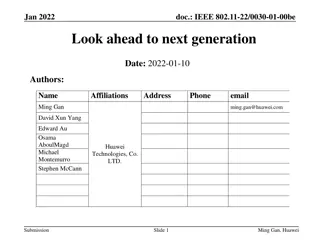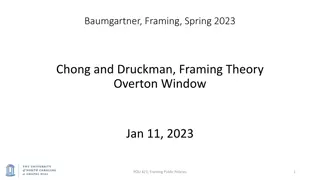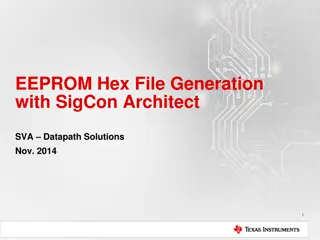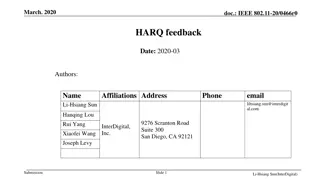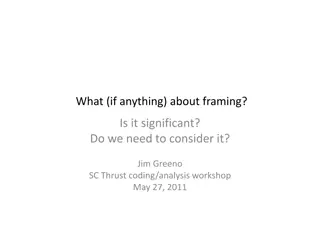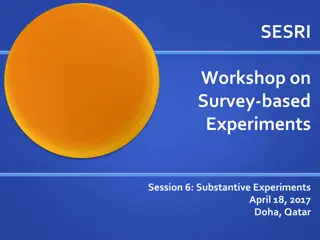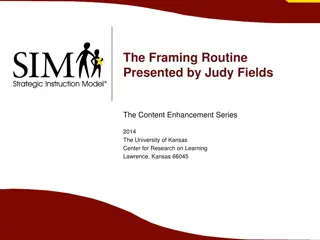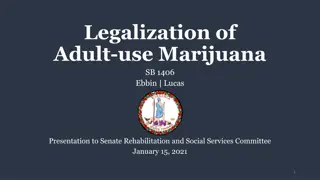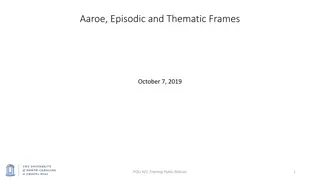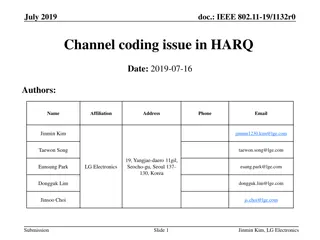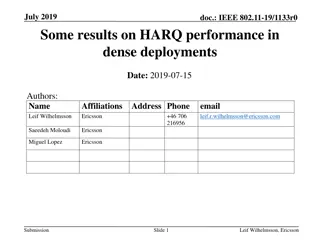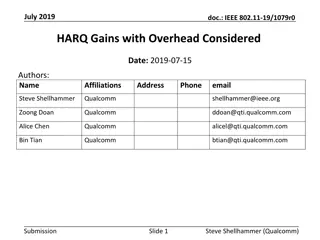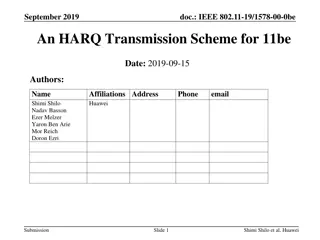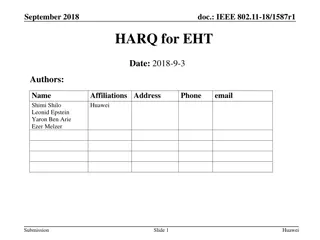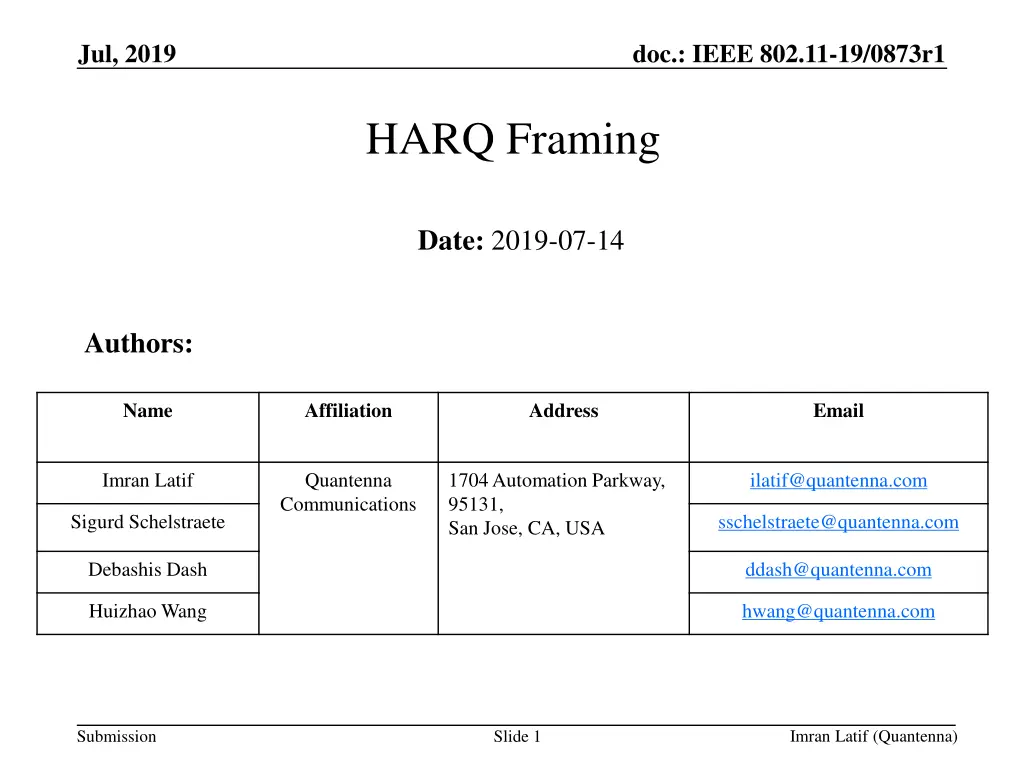
Understanding HARQ Support in IEEE 802.11 for TGbe
Explore the nuances of Hybrid-ARQ (HARQ) support in IEEE 802.11 for TGbe, delving into the granularity at which HARQ can be supported and necessary changes at the PHY and MAC layers for efficient operation. With insights from Imran Latif of Quantenna Communications, unravel the complexities of HARQ framing and its implications on data decoding feedback and retransmissions at different levels. Learn how HARQ at A-MPDU level influences resource efficiency and the challenges it presents in payload combining at the PHY layer.
Download Presentation

Please find below an Image/Link to download the presentation.
The content on the website is provided AS IS for your information and personal use only. It may not be sold, licensed, or shared on other websites without obtaining consent from the author. If you encounter any issues during the download, it is possible that the publisher has removed the file from their server.
You are allowed to download the files provided on this website for personal or commercial use, subject to the condition that they are used lawfully. All files are the property of their respective owners.
The content on the website is provided AS IS for your information and personal use only. It may not be sold, licensed, or shared on other websites without obtaining consent from the author.
E N D
Presentation Transcript
Jul, 2019 doc.: IEEE 802.11-19/0873r1 HARQ Framing Date: 2019-07-14 Authors: Name Affiliation Address Email Imran Latif Quantenna Communications 1704 Automation Parkway, 95131, San Jose, CA, USA ilatif@quantenna.com Sigurd Schelstraete sschelstraete@quantenna.com Debashis Dash ddash@quantenna.com Huizhao Wang hwang@quantenna.com Imran Latif (Quantenna) Submission Slide 1
Jul, 2019 doc.: IEEE 802.11-19/0873r1 Background Hybrid-ARQ is one of the candidate features for TGbe How and at what layer HARQ will be supported needs to be better understood There are intertwined aspects of the PHY and MAC which need to be understood better for HARQ support Therefore, in this presentation we discuss granularity at which HARQ can be supported and what changes would be necessary at the PHY and MAC layer Imran Latif (Quantenna) Submission Slide 2
Jul, 2019 doc.: IEEE 802.11-19/0873r1 HARQ Support HARQ granularity, theoretically, it can be supported at A-MPDU level MPDU level Codeword level HARQ Feedback about the status of data decoding from RX to TX is extremely important and it should be supported on MPDU level (currently supported through MPDU BA feedback) Codeword level ARQ support: in current release (11ax) MPDU retransmissions are supported but these retransmissions are not fit for HARQ type of combining at the RX (elaborated in next few slides) Imran Latif (Quantenna) Submission Slide 3
Jul, 2019 doc.: IEEE 802.11-19/0873r1 HARQ at A-MPDU Level If and when the whole A-MPDU is to be retransmitted, MAC prepares the A- MPDU to be retransmitted However, retransmitted A-MPDU usually has changes as compared to the original transmission because of: Arbitrary numbers of delimiters (DL) among the MPDUs Each MPDU Header s flipped retry bit Different Cipher Text Different CRC bits MPDU Header MIC CRC Ext-IV Cipher Text DL (Delimiter) Pre-FEC Padding MPDU-1 MPDU-2 MPDU-3 MPDU-4 Imran Latif (Quantenna) Submission Slide 4
Jul, 2019 doc.: IEEE 802.11-19/0873r1 HARQ at A-MPDU Level These changes in A-MPDU results in different payload at PHY AT PHY there is no knowledge of MPDUs and this payload is transformed into codewords (CW) for transmission However, the CWs generated for retransmission will definitely be different than the CWs corresponding to the original transmission Thus, due to these few different bits in the MAC payload combining of LLRs at the PHY layer on the RX will not be possible Thus, not only HARQ at A-MPDU level is extremely in-efficient in terms of resource usage, without changes, it is not even possible to combine the retransmitted A-MPDU with previous A-MPDU What changes are to made for making it work? Retransmit the same A-MPDU as from the original transmission? Needs changes at MAC not desirable Imran Latif (Quantenna) Submission Slide 5
Jul, 2019 doc.: IEEE 802.11-19/0873r1 HARQ at MPDU Level Next we discuss the HARQ at MPDU level As is evident from A-MPDU case that MPDU level retransmissions would also not work in their current form in the standard Consider the following example of an A-MPDU which has 4 MPDUs Decoding Failed MPDU-1 MPDU-2 MPDU-3 MPDU-4 CW-4 CW-5 CW-6 CW-7 CW-8 CW-9 CW-1 CW-3 CW-10 CW-11 CW-2 Suppose MPDU-2 was not decoded correctly and needs to be retransmitted MPDU BA based feedback informs the TX that MPDU-2 is not decoded First of all it can be observed that the failed MPDU can span multiple CWs (partially and completely). Imran Latif (Quantenna) Submission Slide 6
Jul, 2019 doc.: IEEE 802.11-19/0873r1 HARQ at MPDU Level Failed MPDU at the RX has two partial CWs and two complete codewords At the TX side this failed MPDU will be mapped onto different CWs and each CW will have different FEC padding This causes the misalignment in the failed and retransmitted MPDU s CWs Due to this misalignment, codeword combining at physical layer is not possible Other than misalignment issue, the failed MPDU will have following bits different in the next transmission, Retry bit Cipher text CRC bits Therefore, due to the different bits at the input of the FEC encoder, the coded bits in the CWs would also be different Thus these CWs cannot be combined at LLR level at the RX side Failed MPDU At the RX CW-4 CW-5 Failed MPDU At the Tx for Retransmission CW-2 CW-3 CW-1 Imran Latif (Quantenna) Submission Slide 7
Jul, 2019 doc.: IEEE 802.11-19/0873r1 HARQ at MPDU Level Though HARQ support at MPDU level is desired, however, due to the reasons mentioned previously, it is not possible in the current form of the 802.11 standard Due to the different payload (even few bits) in each MPDU, the contents of the CWs will change, thus no combining Furthermore, due to the misalignment in the MPDU to CW mapping between first transmission and the retransmissions, it is still not possible to combine LLRs for MPDU level HARQ Since there is no knowledge of MPDUs at the PHY so even PHY level retransmission (without packing of MAC) is not possible Even if SAME MPDU is to be sent over medium, due to the possible misalignment in the CWs, partial CW combining won t be possible at the RX Imran Latif (Quantenna) Submission Slide 8
Jul, 2019 doc.: IEEE 802.11-19/0873r1 HARQ at CW Level As seen so far, that MAC level packing is problematic for HARQ HARQ from pure PHY seems the way forward However, in current form there is no support of PHY level retransmission as well Lets consider the CW level retransmission for HARQ and see what kind of changes would be required in 11be Imran Latif (Quantenna) Submission Slide 9
Jul, 2019 doc.: IEEE 802.11-19/0873r1 HARQ at CW Level Codeword level HARQ requires that RX at the PHY should know that it has received an erroneous codeword so that it can use this knowledge for combining of the retransmitted CWs However, PHY at the RX does not have any CRC, but it can use LDPC Parity Check to see if it needs to store this codeword or not. Additionally, the MAC layer can inform the PHY by checking CRC about the status of MPDUs and PHY can associate failed CWs to MPDUs RX then needs to send back the feedback about failed CWs to the TX Tx would needs to store the original payload at PHY level and it will need to retransmit only the codewords which are asked for in the feedback To do this, we present two solutions in this contribution Imran Latif (Quantenna) Submission Slide 10
Jul, 2019 doc.: IEEE 802.11-19/0873r1 Solution 1: 2-tier HARQ Let s take the same example as before, MPDU 2 decoding failed Decoding Failed MPDU-1 MPDU-2 MPDU-3 MPDU-4 CW-4 CW-5 CW-6 CW-7 CW-8 CW-9 CW-1 CW-3 CW-10 CW-11 CW-2 In this case the RX sets up a HARQ session between TX and RX by asking for CW-3 to CW-6 in the retransmission RX does that by sending a CW level feedback to the TX A prior is that TX needs to store the CWs at the PHY level On reception of the CW level feedback, TX packs only the CW-3 to 6 in a dedicated retransmission packet and sends this to the RX Retransmission CW-4 CW-6 CW-5 CW-3 RX receives these CWs and combines them with previous codewords and forwards the (if all correctly) decoded bitstream to the MAC The MAC performs the CRC check and terminates the HARQ session by sending MPDU level feedback to the TX Imran Latif (Quantenna) Submission Slide 11
Jul, 2019 doc.: IEEE 802.11-19/0873r1 Solution 1: 2-tier HARQ In this case the HARQ session remains active for as long as the RX decides to keep it active To terminate the session the RX sends back the legacy MPDU block acknowledgement This whole process is shown below TX RX Codeword NACK & Retransmit Time Imran Latif (Quantenna) Submission Slide 12
Jul, 2019 doc.: IEEE 802.11-19/0873r1 Solution 1: 2-tier HARQ Receiver initiates an HARQ session for each transmission until it is either successful or reaches maximum HARQ retransmissions (not discussed here) This requires the HARQ session to be finished before a new transmission can be started on the medium Though this is simple and straight forward to implement (with minimum changes in transmitter and receiver side) It can be very in-efficient as the medium stays busy for longer time No other transmission can be combined with the retransmission Imran Latif (Quantenna) Submission Slide 13
Jul, 2019 doc.: IEEE 802.11-19/0873r1 Solution 2: Efficient 2-tier HARQ Lets take the same example as before, MPDU 2 failed and it is encompassing CW 3 6 Decoding Failed MPDU-1 MPDU-2 MPDU-3 MPDU-4 CW-4 CW-5 CW-6 CW-7 CW-8 CW-9 CW-1 CW-3 CW-10 CW-11 CW-2 The bitstream at the output of the decoder is presented to the MAC for parsing. This includes identifying subframe delimiters and verifying the CRCs of any subframes that are found in this way. This allows the MAC to determine that MPDUs 1, 3 and 4 were received correctly. At the same time, the PHY can identify the locations of the codewords that were not decoded correctly (invalid parity). Imran Latif (Quantenna) Submission Slide 14
Jul, 2019 doc.: IEEE 802.11-19/0873r1 Solution 2: Efficient 2-tier HARQ The information from MAC (MPDU) and PHY (codewords) can now be combined into a single ACK that acknowledges reception of MPDU 1, 3 and 4 and requests retransmission of codewords 3 to 6 MPDU BA bit mask Codeword level Feedback TX RX Such a dual feedback is more efficient than creating an HARQ session and multiple compression schemes can be applied on codeword level feedback (The compression schemes are not discussed here) Time Imran Latif (Quantenna) Submission Slide 15
Jul, 2019 doc.: IEEE 802.11-19/0873r1 Solution 2: Efficient 2-tier HARQ On receiving the dual feedback from RX , the TX gets the knowledge that it has to prepend codewords 3-6 with the new A-MPDU packet Decoding Failed MPDU-1 MPDU-2 MPDU-3 MPDU-4 CW-4 CW-5 CW-6 CW-7 CW-8 CW-9 CW-1 CW-3 CW-10 CW-11 CW-2 The MAC prepares the full AMPDU with new MPDUs (5 7 in the example below) MAC sends the AMPDU to PHY PHY prepends CW 3-6 to AMPDU Then the combined transmission happens as shown below PHY level Retransmission MPDU-5 MPDU-6 MPDU-7 CW-4 CW-6 CW-5 CW-3 CW-12 CW-13 CW-14 CW-15 CW-16 CW-17 CW-18 CW-19 Imran Latif (Quantenna) Submission Slide 16
Jul, 2019 doc.: IEEE 802.11-19/0873r1 Solution 2: Efficient 2-tier HARQ However, the boundary between the retransmitted codewords and the new payload needs to be signaled to the PHY To convey this information, we propose to add a new SIG field in the PHY which shall provide minimum information required to RX for combining the required CWs HARQ-SIG DATA L-STF L-LTF L-SIG Legacy Preamble HARQ Control Information On reception of retransmitted data, the PHY combines the retransmitted codewords with the bit positions known to be in error in the previous payload Decoding Failed MPDU-1 MPDU-2 MPDU-3 MPDU-4 CW-4 CW-5 + CW-6 CW-7 CW-8 CW-9 CW-1 CW-3 CW-10 CW-11 CW-2 CW-4 CW-6 CW-5 CW-3 Imran Latif (Quantenna) Submission Slide 17
Jul, 2019 doc.: IEEE 802.11-19/0873r1 Solution 2: Efficient 2-tier HARQ RX only combines the previously stored CWs and tries to decode the full payload Assume that with the retransmission the decoding was successful for previously failed MPDU, i.e., codewords 3 to 6 and new payload Then the decoded bit stream is again presented to the MAC for parsing The MAC now determines that in addition to the MPDUs 1, 3 and 4, also MPDU 2 is correctly received. At the same time, RX MAC will also parse the new payload containing MPDUs 5 to 7. If we assume all of these are correct, the receiver can send a traditional ACK for all MPDUs If some MPDUS and CW are not decoded correctly, then RX can send again 2-tier feedback and TX can combine the failed CWs with new transmission containing fresh payload as well Slide 18 Imran Latif (Quantenna) Submission
Jul, 2019 doc.: IEEE 802.11-19/0873r1 Solution 2: Efficient 2-tier HARQ This approach is spectrally efficient and does not need to setup any HARQ session Its independent to HARQ scheme It can support both CC and IR HARQ (single bit signaling, details not discussed here) It can pack retransmissions with new data Due to the introduction of SIG field (which can be pre-coded) it can also support MU operations (OFDMA and/or MU MIMO) Changes required for 11be as compared to 11ax: TX side PHY layer payload to be stored New HARQ SIG field (design can be optimized) RX side: parity check operation for CWs 2-tier feedback support Imran Latif (Quantenna) Submission Slide 19
Jul, 2019 doc.: IEEE 802.11-19/0873r1 Summary We have discussed the Framing for HARQ We have shown HARQ can be implemented on various layers We presented issues with some of these implementations and possible solutions to those problems We showed that CW level HARQ is a natural fit for HARQ in 11be We presented two CW level HARQ solutions A simple approach of codeword NACK and retransmission will work, but it is less efficient For efficiency and high performance, efficient 2-tier HARQ seems suitable Imran Latif (Quantenna) Submission Slide 20






